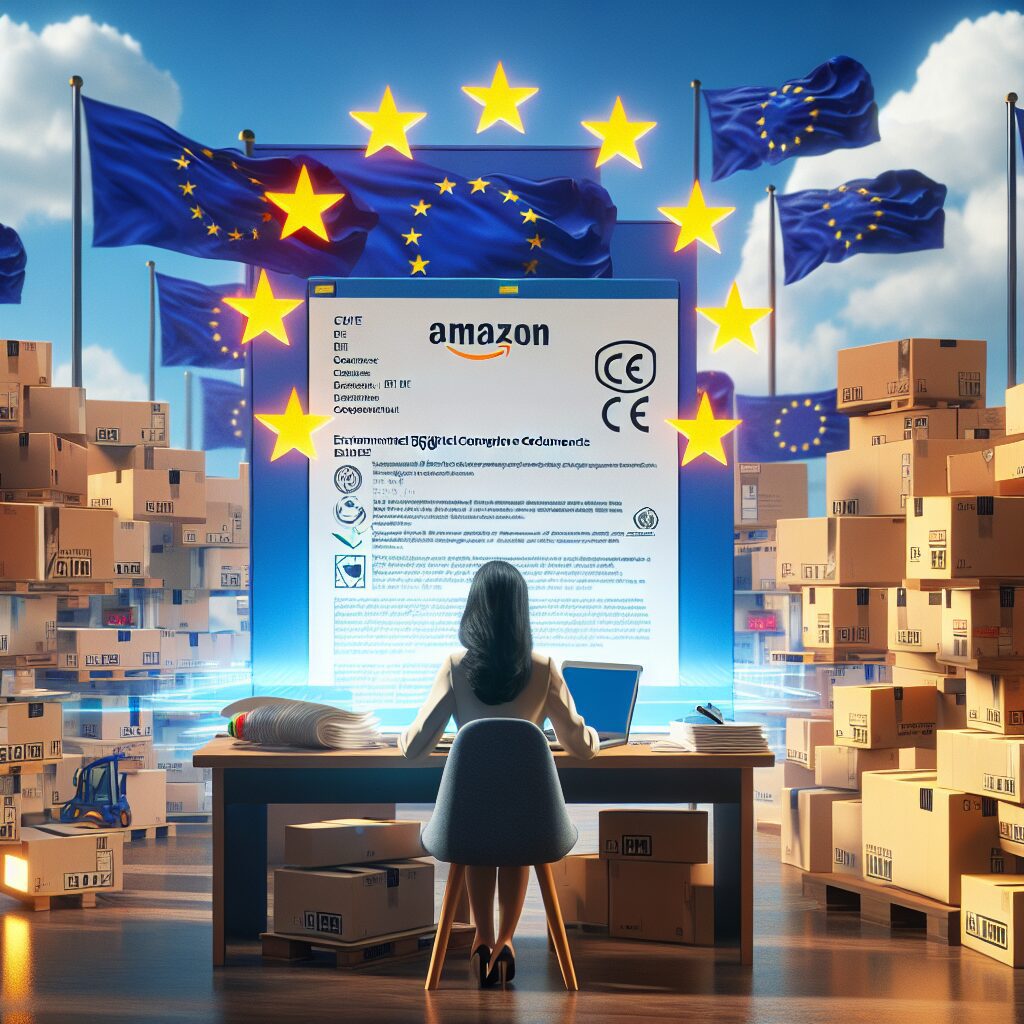About eldris
At Eldris, we automate SEO, multilingual site expansion, and EU compliance for brands scaling across Europe. Our AI-powered platform handles everything from content publishing to regulatory docs—so you don’t have to.
In This Article
- Amazon EU compliance is mandatory for sellers of regulated products
- CE marking and EPR laws are non-negotiable in 2024
- Documentation, localisation, and label accuracy are key to success
- Technological tools like Eldris AI can automate complex workflows
- Proactive sellers mitigate risk and build customer confidence
Understanding Legal Obligations for EU Amazon Sellers
Why Compliance Matters in 2024
Amazon EU compliance is a pressing concern for all businesses looking to sell within the European Economic Area. As the regulatory landscape evolves in 2024, both large enterprises and independent third-party sellers are under increasing scrutiny. Not only are national customs tightening inspections, but Amazon itself has also stepped up enforcement, imposing stricter compliance checks to align with EU legislation. Consequently, non-compliant sellers risk account suspensions, removal of listings, financial penalties, and even full bans.
Beyond regulatory threats, there’s gaining consumer trust. Europe’s consumer base is more legally aware, and product pages that lack proper documentation or fail to demonstrate safety assurances are likely to perform worse in the marketplace. Thus, aligning your business with Amazon EU compliance is critical not just for legality but also for competitive positioning and customer acquisition.

Mandatory Documentation & Certificates
Product Safety Files, Test Reports, and Manuals
Amazon mandates comprehensive product documentation that complies with EU law. This includes—but is not limited to—Declaration of Conformity (DoC), Technical Files, Safety Data Sheets (SDS), and user manuals written in the local language of every market of sale. Manufacturers and sellers must be able to present this information instantly upon request.
Test reports and third-party certifications verifying compliance with harmonised EU standards are also essential. For example, toys require EN 71 certificates, electronic equipment must comply with EMC and LVD directives, and cosmetic products must be registered with the CPNP portal through a Responsible Person. Without these test reports, your products are legally prohibited from being sold.
“Failing to provide authentic, traceable compliance documentation is one of the top reasons Amazon suspends EU seller accounts.”
What is CE Marking and How to Obtain It
The CE marking is a visible symbol of a product’s compliance with EU safety, health, and environmental protection standards. For Amazon EU compliance, CE marking is not optional for products within certain regulatory scopes. These include electronics, machinery, toys, construction products, medical devices, PPE, and more.
To obtain a CE mark, sellers must ensure their product meets all applicable directives. The process includes risk assessment, conformity testing, technical dossier preparation, and creating a Declaration of Conformity. In some cases, third-party Notified Bodies are necessary to perform conformity assessments. Once cleared, the CE logo must be affixed physically to the product and packaging.
Importantly, sellers must retain all compliance documents for a minimum of 10 years, as per EU law. Amazon may request these documents at any point, especially if a product is flagged by an automated safety scan or consumer complaint. Failure to produce valid CE documents will invariably lead to de-listing or regulatory action.
Understanding Extended Producer Responsibility (EPR)
Extended Producer Responsibility (EPR) is a legal framework requiring sellers to manage the lifecycle impact of their products—especially in terms of recycling and disposal. In countries like Germany and France, Amazon EU compliance now requires registration with waste management schemes for packaging, electric devices, and batteries.
EPR registration numbers must be submitted to Amazon through its Seller Central interface. Without them, listings in affected categories may be suppressed. For example, if you sell electronics in Germany, you must obtain a WEEE registration number from Stiftung EAR. For France, EPR requirements are broader and often require involvement with authorised environmental partners such as Ademe-approved organisations.
Non-compliance with EPR not only leads to fines imposed by local environmental authorities but also results in Amazon removing sellers’ listings. EPR represents a shift towards circular economy principles, and all platforms operating legally within the EU must enforce these laws.
Responsible Person Requirement for EU Market
Since the implementation of the EU Market Surveillance Regulation in mid-2021, Amazon sellers are required to appoint a Responsible Person (RP) when selling CE-marked products into the EU. The RP acts as the legal representative within the EU and must be identifiable on product labelling and documentation.
The Role of the Responsible Person is not to be taken lightly. They must ensure product safety files are complete, validate CE conformity, communicate with EU authorities when necessary, and assist during audits or recalls. Non-EU sellers must appoint this individual or legal entity before importing any regulated goods into Europe.
Amazon enforces Responsible Person information by requiring sellers to input contact details through Seller Central. Products lacking an RP name may be removed. This obligation enhances transparency and makes regulatory enforcement more efficient throughout the European supply chain.
Top Compliance Challenges on Amazon Europe
Despite widespread awareness among sellers, several compliance challenges persist on the Amazon EU platform. One major hurdle is the localisation of labelling across different EU countries. Sellers often mistakenly assume that English-only documents and packaging are sufficient for all EU markets—which is not the case.
Another challenge is managing the regulatory divergence post-Brexit. UK-issued CE marks are no longer valid in the EU. Sellers exporting from the UK must work with EU-based importers or legal entities to regain access to the European market. Product harmonisation sometimes varies as well, especially if national laws add additional layers of compliance.
Moreover, counterfeit documentation is a growing issue. Amazon actively suspends sellers who use forged certificates, having implemented stringent AI-based document inspections. Quick-fix compliance strategies are no longer viable. Sellers must invest in authentic processes and retain detailed audit trails.
Changes in Amazon EU Compliance for 2024
The compliance environment for Amazon EU sellers is becoming even more sophisticated. In 2024, changes include broader EPR enforcement across new countries like Spain and Austria, mandatory QR codes on packaging to link to online manuals, and additional requirements for AI-enabled and IoT (Internet of Things) devices, which must follow new cybersecurity standards.
Additionally, Amazon is now enforcing Sustainable Product Regulations, including energy labelling updates and eco-design requirements on specific product categories. The company’s new “Sustainability Badge” programme gives preferential placement to EU-compliant listings, providing a commercial incentive for rigorous compliance.
These developments underscore that Amazon EU compliance is a dynamic objective. Sellers must review their portfolios regularly and adapt to new requirements quickly to stay competitive and avoid penalties.
Tools to Automate Amazon Compliance Tasks
Managing Amazon EU compliance manually is not only time consuming but also error-prone. Thankfully, a growing number of tech platforms now help automate key compliance functions. Tools like Amazon Compliance Reference Centre, EPR partner integrations, and third-party compliance monitoring dashboards offer much-needed support.
AI solutions can auto-generate localisation-ready labels and documentation using structured product data. Some platforms even pre-validate CE documentation before Amazon submission. Integration with government registries through APIs enables faster verification of Responsible Person data and EPR registration results.
Using automation also helps sellers meet the requirement of real-time document validation, now enforced by Amazon’s listing management system in categories like toys and electronics. Reducing friction in compliance tasks frees up energy for sellers to grow inventory and enhance customer service.
Best Practices for Product Labelling & Packaging
For Amazon EU compliance, product labelling and packaging must adhere strictly to EU directives. All labels must contain product names, manufacturer addresses, batch or serial numbers, conformity markings (such as CE), and translated safety warnings wherever applicable. Omitting even one of these elements could render the product non-compliant.
Additionally, the font size, visibility, and durableness of labels are scrutinised by customs and Amazon alike. Using a standardised layout and QR codes that link to real-time compliance documentation is strongly recommended.
Packaging must also respect environmental directives—such as the Packaging Waste Directive—meaning it must be easily recyclable, marked with recycling symbols, and ideally produced from sustainable materials. Following these best practices not only ensures compliance but enhances your eco-credentials with European consumers.
How Eldris AI Helps Streamline EU Compliance
Staying abreast of evolving regulatory requirements can overwhelm even seasoned Amazon sellers. Eldris AI provides a suite of powerful tools tailored specifically to Amazon EU compliance, integrating legal logic with artificial intelligence to handle documentation generation, localisation, and verification at scale.
With auto-translation, CE document generation, and EPR tracking modules, Eldris AI reduces human error and ensures consistency across all EU listings. It also alerts sellers to rule changes in their specific product categories and automatically updates label templates to remain compliant.
By leveraging AI and regulatory data, Eldris gives sellers an invaluable edge in maintaining perfect marketplace health. Learn more about E-commerce Compliance and Risk Management in Europe
Final Compliance Checklist for Sellers
Before launching or continuing your Amazon selling journey in Europe, review this final checklist to ensure alignment with Amazon EU compliance regulations:
- ✅ All CE-marked products have updated Declarations of Conformity and Technical Files
- ✅ Responsible Person information is entered and visible in Seller Central
- ✅ Translated user manuals and safety documents for all EU languages you operate in
- ✅ Valid EPR registration numbers for packaging, electronics, and batteries per country
- ✅ Sustainable packaging aligned with waste directives and recyclability laws
- ✅ Mandatory labelling includes traceability and safety symbols as required
- ✅ Internal audit logs stored for at least 10 years
- ✅ No use of fake or altered documentation
Conclusion: Stay Compliant, Grow Confidently
In conclusion, Amazon EU compliance is not a one-time hurdle—it is an ongoing strategic necessity. While the regulatory framework may appear complex, meeting these obligations pays off substantially through reduced risk, better customer trust, and sustained access to one of the world’s largest online marketplaces.
Sellers who take an informed, proactive approach—particularly those integrating tools like Eldris AI—will find themselves at the forefront of e-commerce excellence. Now is the time to audit your processes, review your documents, and act with precision. Read a related article Essential Amazon seller compliance documents
Great guide on legal-compliance-requirements-amazon-sellers-europe – Community Feedback
What compliance documents are needed to sell on Amazon Europe?
Sellers need safety certificates, test reports, CE markings, product labels, user manuals, and, depending on the product type, additional compliance proofs such as EPR registration, VAT documents, or responsible person details.
How does EPR affect Amazon sellers in the EU?
Extended Producer Responsibility (EPR) regulations require Amazon sellers to register their products, track material use, and provide compliance numbers for environmental categories such as packaging or electronics.
Do I need an EU Responsible Person for Amazon sales?
Yes, for many products including cosmetics, electronics, and medical devices, an authorised representative or EU Responsible Person is legally required on product documentation and labelling.








